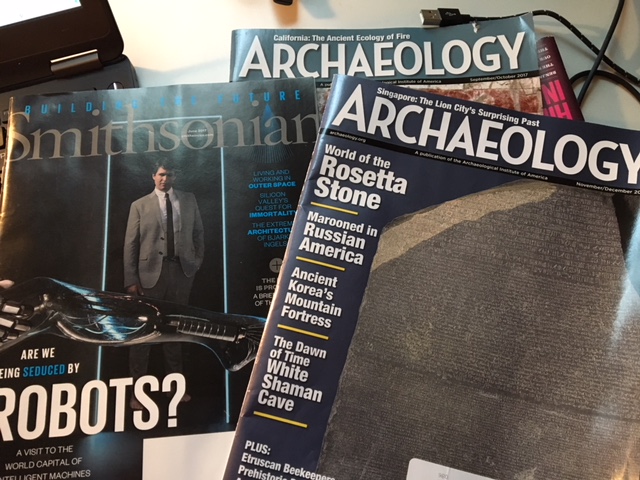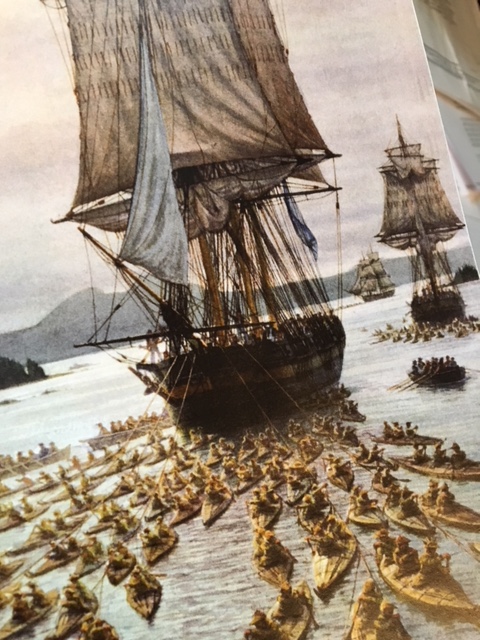10.30.17Some Ideas for Sourcing Embedded Nonfiction

Facts don’t stay disconnected for long. They have a way of connecting… Sometimes it’s worthwhile to start with the source
One of the most frequent comments we get about the idea of embedding nonfiction articles in primary texts is: “I love the idea, but where do I find the articles?”
Generally we think this is a great place for schools to coordinate and information share–and as an aside we are working on developing lesson materials materials with lots of embedded nonfiction.
But in the meantime here are some thoughts on one of my favorite ways to find articles.
I subscribe to a couple of magazines that I think are really outstanding–Archaeology and Smithsonian are two good examples. The magazines are full of articles, large and small, that connect to fiction generally and historical fiction in particular. Often in ways that are surprising. I’ll be reading and suddenly I’ll think– a ha!. Plus their writing is both high quality and backed by excellent pictures and graphics. This is important. Quality counts. Often I’d rather use a great article where the connection is a bit more of a stretch than a lesser article.
A good example of that comes from the November/December 2017 issue of Archaeology, which includes an article on the excavation of a fortress in Korea dating from roughly the fifth or sixth century. While this is a long way from the 12th century setting of Linda Sue Park’s A Single Shard (one of my very favorite novels), there’s plenty to connect to it–not least how they discover things about ancient societies through digging them up. But you could also connect the article’s discussion of the Goguryeo Kingdom–an early dynasty with vast geographic holdings, to the dynasty in the book which we see governed and administered in various scenes. And there’s a reference to how critical oven and forges and kilns were to archaeologists in discovering the past. In short there is plenty to connect to in the book to justify reading excerpts of the article and doing so would both expand students’ understanding of the book and their background knowledge generally in important ways.
The issue also contains an article about efforts to unearth the wreck of a Russian ship that sank in the early 1800’s off the coast of Alaska. I was immediately struck by the tie-in to another of my favorite novels for young people, Island of the Blue Dolphins. Karana’s people are annihilated by Russian seal merchants at about this historical period. So reading their story–how they build a fort in what is now Alaska, what devastating the cost was to the Tlingit people, how they ran the commercial trade and how dangerous it was are fascinating–and relatively unexplored–subplots that could be developed by the article. Even this picture in the article, showing the size of a Russian ship compared to native watercraft gives a sense for why Karana’s people were vanquished despite their bravery.

At the same time the article is hugely rich in facts about science and history that will be broadly applicable to students after the novel has come to a close.
There are other great articles in the issue, in particular two about the ‘Rosetta Stone‘ which frankly I would include in any novel that uses that phrase or any novel that talks about codes or code breaking or even the difference between symbolic and letter-based written languages and I think how one might use it is important:
- First and foremost I would choose my articles based on quality and importance of the background knowledge they provide and then find a connection
- I would have students read selected portions of the article but perhaps not all of it, choosing interesting and analogous parts.
- I would connect articles to both major themes and seemingly small details in the novel.
- I would just as often start with the article and look for a connection as I would start with a desired topic and look for an article.
Before I wrap up let me share a second favorite source of articles for embedded nonfiction. Smithsonian Magazine, like Archaeology, is rich in very well written articles full of scientific and historical detail and graphics to support. So again I might start my embedding by flipping through its pages. In the June 2017 issue–which happens to be on my night-table–I found articles on scientists’ quest to uncover the secret of immortality–and whether that was a good thing. I thought immediately of Tuck Everlasting though there are probably a dozen more books where the idea of immortality is a tie-in. There’s also a picture of a mouse, used in a lab to have its aging accelerated. I thought instantly about another favorite book Mrs. Frisby and the Rats of NIMH: Why DO scientists do these things to rats and mice? Is it worth it? etc.
There’s also a timeline of important futurist texts in society–movies, novels and nonficiton–that include the Hunger Games but also references Jules Verne and George Orwell. Perfect for helping students see the historical context of a literary idea.
Anyway to reiterate and expand:
It’s just as useful to start with sources of high quality nonfiction and mine the connections you find as it is to start with the novel and look for perfect matches.
Quality counts.
And finally don’t forget the value of “flipping through” periodicals… i.e. looking at everything in them rather than finding everything via a google search. The benefits are surprising. Facts, someone or other said, don’t stay disconnected in our minds for long. They have a way of connecting…

Wouldn’t it be great if authors started to share their research notes and sources at the back of their novels?